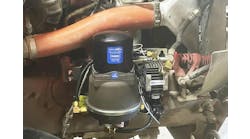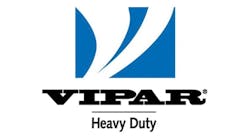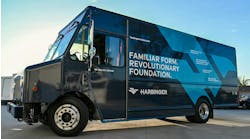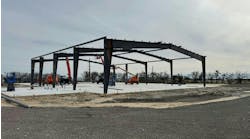Some people do not like overweight trucks. Some people do not like math. Richard Toner, president of Toner Associates and the NTEA's first staff engineer, had something to offer both groups by explaining an easy "weigh" to calculate truck weight distribution.
The people who do not like overweight trucks include the truck customer whose vehicle does not perform long enough or well enough because of excessive weight on one or more axles, those who enforce state weight laws, and the National Highway Traffic Safety Administration.
A lot of people do not like math, so Toner developed an easy way to calculate weight distribution-with a computer spreadsheet that does the math based on values that are entered.
The spreadsheets, which run on Microsoft Excel, are available from the NTEA office in Farmington Hills, Michigan. Although the computer performs the calculations based on the engineering formulas Toner has entered, the accuracy of the results depends on the data entered for the chassis, body, and equipment.
Most of the chassis data involves dimensions. These include the distance from the axle to the end of the frame (AF), bumper to axle (BA), bumper to back of cab (BBC), cab to axle (CA), cab to body (CB), cab to the end of the frame (CE), frame height (FH), overall length (OAL), and wheelbase (WB). The length of the truck body that will be installed (BL) is another important dimension.
Starting in the Middle One way to begin an analysis of truck weight distribution is to locate the center of gravity-the point about which all of the mass of the vehicle is evenly distributed. It is at this point that the truck is balanced-horizontally, longitudinally, and laterally. The center of gravity provides a reference point on the truck from which other calculations can be measured. These calculations include weight distribution, effective wheelbase, and compliance with federal motor vehicle safety standards (FMVSS).
Horizontal centers of gravity are measured from the front axle. Dimensions behind the front axle are considered positive, and locations ahead of the front axle are negative.
Lateral centers of gravity are measured from the vehicle's longitudinal centerline. Locations to the right of the longitudinal centerline are positive, and distances to the left of the centerline are negative. Longitudinal centers of gravity are used to calculate the load placed on individual wheels.
Vertical centers of gravity are measured from either the ground or the top of the frame rail at the back of the cab. The measuring point varies according to different federal motor vehicle safety standards. Calculating compliance with FMVSS 105 involves measuring the vertical center of gravity from the ground. Federal safety standards such as FMVSS 212 and 219 use the top of the frame rail as the reference point for measuring the vertical center of gravity.
"Any point, though, can be used for the reference as long as it is consistent," Toner said.
Moments are another concept used in calculating centers of gravity, weight distribution, frame moments, and effective wheelbases.
Moments are force times distance. They can be measured in foot-pounds or inch-pounds. Much like a torque wrench measures the torque generated as the wrench revolves around a nut, the spreadsheet calculates loads placed on the truck axles.
Using dimensions and weights available from chassis manufacturers, truck body manufacturers, and truck equipment manufacturers, Toner demonstrated how these numbers can be used to determine whether a customer's proposed vehicle is feasible-and legal-before it is built or purchased.
"Will the final truck be under the gross vehicle weight rating?" Toner asked before entering the final variable into the computer. "In this case, it is. We have a 9,600-lb GVW truck that will weigh 8,704. But if the customer has higher cargo requirements than what we used in the example, we may not be able to use the same chassis. We need not go any further, because we know we can't build that truck."
One part of Toner's example that raised questions was a 60-lb winch installed 36 inches ahead of the front axle. Toner entered the dimension as a negative number because the winch was ahead of the front axle.
"The figure is negative because it moves the center of gravity forward," he said. "Any load you put outside of an axle will take weight off the other axle. If I put something outside the front axle, it will take weight off the rear. Likewise, installing a liftgate takes weight off the front axle and places it on the rear."
If the result places too much weight on an axle, one possible solution is to get a longer wheelbase or slide the axle back, Toner said. "That is one reason to do these calculations up front-so that the customer knows what wheelbase to buy."
In one example, a customer wanted to install a dump body and hoist on a single-axle truck. The weight of the chassis, body, equipment, and customer's desired payload exceeded the capacity of the truck. By adding a pusher axle and adjusting the wheelbase of the truck, the computer determined what the dimensions should be for a truck that would do the job.
In another example, Toner showed how to calculate the weight distribution on the same dump truck after adding a pup trailer. Initially the tongue weight of the pup trailer overloaded the rear axle. One possible solution was to move the rear axles forward and slightly reduce the payload.
"Obviously, there are physical constraints on any truck. You can only move the axles so far," Toner said. "We really need to get a longer wheelbase. When the load is too much on the rear axle, the wheelbase needs to be longer.
"These are some of the examples of the analysis that can be done to calculate weight distribution under different conditions. It is particularly important for trucks that pull trailers. Most people do the analysis on the truck but forget about the trailer. But if you load a backhoe on a trailer and pull it behind a dump truck, you have a whole new ballgame."








